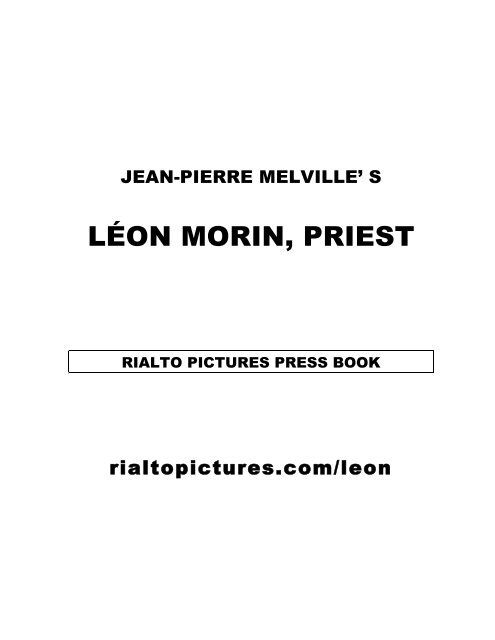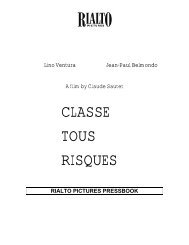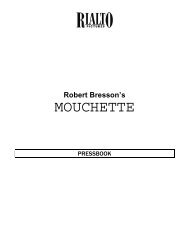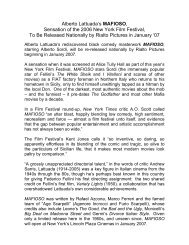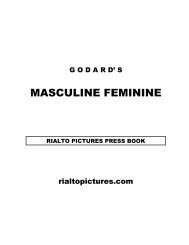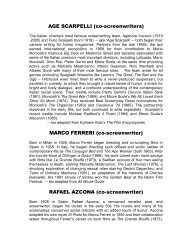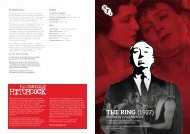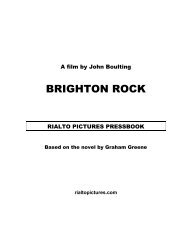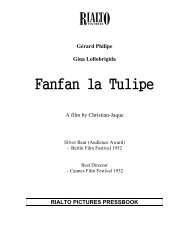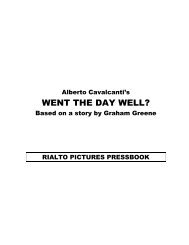LEON MORIN, PRIEST PB v9 - Rialto Pictures
LEON MORIN, PRIEST PB v9 - Rialto Pictures
LEON MORIN, PRIEST PB v9 - Rialto Pictures
You also want an ePaper? Increase the reach of your titles
YUMPU automatically turns print PDFs into web optimized ePapers that Google loves.
JEAN-PIERRE MELVILLE’ S<br />
LÉON <strong>MORIN</strong>, <strong>PRIEST</strong><br />
RIALTO PICTURES PRESS BOOK<br />
rialtopictures.com/leon
LÉON <strong>MORIN</strong>, <strong>PRIEST</strong><br />
RIALTO PICTURES <br />
Director<br />
Jean-Pierre Melville<br />
Screenplay<br />
Jean-Pierre Melville<br />
Based on on the novel by<br />
Béatrix Beck<br />
Producers<br />
Georges de Beauregard<br />
Carlo Ponti<br />
Cinematography<br />
Henri Decaë<br />
Editors<br />
Jacqueline Meppiel<br />
Nadine Trintignant<br />
Marie-Josèphe Yoyotte<br />
Music<br />
Martial Solal<br />
Albert Raisner (harmonica)<br />
Assistant Directors<br />
Luc Andrieux, Volker Schlöndorff, Jacqueline Parey<br />
A French – Italian co-production<br />
Produced by Rome Paris Films – Concordia Compagnia Cinematografica<br />
First released on September 22, 1961<br />
A RIALTO PICTURES RELEASE<br />
rialtopictures.com/leon<br />
France, 1961 running time: 117 min.<br />
aspect ratio: 1.66:1 In French with English subtitles<br />
2
LÉON <strong>MORIN</strong>, <strong>PRIEST</strong><br />
RIALTO PICTURES <br />
CAST<br />
Barny<br />
Emmanuelle Riva<br />
Léon Morin<br />
Jean-Paul Belmondo<br />
Christine<br />
Irène Tunc<br />
Sabine<br />
Nicole Mirel<br />
Lucienne<br />
Gisèle Grimm<br />
Arlette<br />
Monique Hennessy<br />
France<br />
Chantal, Marielle & Patricia Gozzi (alternating)<br />
GIs<br />
Cedric Grant & George Lambert<br />
Edelman<br />
Marco Behar<br />
Günther<br />
Gérard Buhr<br />
German Officer<br />
Howard Vernon<br />
3
LÉON <strong>MORIN</strong>, <strong>PRIEST</strong><br />
RIALTO PICTURES <br />
SYNOPSIS<br />
In a small French provincial town during the Occupation, Barny (Emmanuele Riva)<br />
is a young widow who works grading papers for a correspondence school that has<br />
been evacuated from Paris. Italian Bersaglieri (noted for their feathered hats) and<br />
a German marching band parade through the town, and in a manless world, Barny<br />
nurses a crush on Sabine Levy (Nicole Mirel), her supervisor at work (but she<br />
protests “You’re mad!” when a co-worker insinuates that Barny really wants to<br />
sleep with Sabine). A group of women carefully work out who will be the<br />
godparents when they decide to get all their children baptized to conceal possible<br />
Jewish or Communist links (Barny’s late husband was Jewish).<br />
Passing St. Bernard’s church, baptized atheist Barny, suddenly irked because the<br />
priests “live off our money,” stalks into confession quoting Marx: “Religion is the<br />
opiate of the people.” But after the priest, Léon Morin (Jean-Paul Belmondo)<br />
startles her by replying “Not exactly,” she finds herself maneuvered into a<br />
confession, doing a kneeling penance on the church floor, and coming back two<br />
days later to the rectory, where Morin lends her a book.<br />
As deportations begin in the town, Barny’s co-worker Christine Sangredin (Irène<br />
Tunc) barks “Yids aren’t French” in hearing range of Professor Edelman (Marco<br />
Behar), who returns to the office late at night preparing for flight, disguised<br />
completely via a haircut and a shave of his beard. Goaded by Christine’s bitchy<br />
behavior, Barny slaps her, to which Christine eventually replies with a kiss. It turns<br />
out Morin is her confessor, too; he also puts up Jews on the run and gives them<br />
baptismal certificates. Barny’s little daughter France (played, alternately, by sisters<br />
Marielle, Chantal, and Patricia Gozzi) is taught about God in school by Morin, and<br />
befriends Gunther (Gérard Buhr), a German soldier slated for the Russian front.<br />
In the course of her conversations with Morin, Barny reveals she satisfies herself<br />
sexually with a piece of wood, but grudgingly admits that she is starting to believe.<br />
And after an epiphany while cleaning out her attic, she announces that “I’m<br />
converted”; Morin at first seems almost to talk her out of it, but then takes her first<br />
serious confession.<br />
Barny brings Arlette (Monique Hennessy) to see Morin; she pronounces him<br />
handsome, which Barny hadn’t realized consciously herself. Christine brings<br />
Marion (Monique Bertho), who has five different lovers, to see Morin as well. She<br />
tries unsuccessfully to seduce him, then ends up at confession herself.<br />
At a railroad crossing Barny is reprimanded by a German soldier. 1<br />
1 The soldier is played by Volker Schlondörff, Melville’s assistant director on this and<br />
other films, who went on to his own distinguished directing career (The Tin Drum, etc.)<br />
4
LÉON <strong>MORIN</strong>, <strong>PRIEST</strong><br />
RIALTO PICTURES <br />
And suddenly the town wakes free as the Liberation has come, with confessed<br />
Vichy-ite 2 Christine fretting that “I’ll be shot”, and two American G.I.’s escorting<br />
Barny and France home.<br />
In their final meetings, Morin talks to Barny about his childhood, rudely brushes<br />
past her at Mass, and at last comes to her – but only in a dream. She finally asks<br />
him if he would marry her if he were a Protestant (his smiling reply, “Of course”),<br />
then asks him if he would marry her if he weren’t a priest, to which he wordlessly<br />
sinks an axe into a chopping block and stalks out angrily. After a long interval, he<br />
again visits for a complex philosophy discussion and she finally reaches out to<br />
him—he springs back and says she must confess this. She does the next day and<br />
finds herself at peace. After he announces that he’s leaving on a mission to a<br />
remote area, even as she prepares to return to Paris, they have a final meeting.<br />
PRODUCTION NOTES<br />
After the resounding flop of Deux Hommes dans Manhattan in 1959, Jean-Pierre<br />
Melville had “had enough of being an auteur maudit known only to a handful of<br />
crazy film buffs.” Mainstream producers Georges de Beauregard and Carlo Ponti<br />
(Sophia Loren’s husband) had asked him to make a film for them, obviously one<br />
with a large budget, and with stars. Melville himself selected Béatrix Beck’s<br />
autobiographical, Goncourt Prize-winning novel Léon Morin, Prêtre (published in<br />
English as The Passionate Heart 3 ), having wanted to film it since its publication in<br />
1952. Melville called it “the most accurate picture I have read of the life of French<br />
people under the Occupation,” but he claimed what particularly attracted him was<br />
the character of Morin --“Had I been a priest I would have acted as he did”: a<br />
striking remark from a Jewish atheist. “Faith, whether in God or Marx, is a thing of<br />
the past.”<br />
While Melville was acquainted with Béatrix Beck, he wrote the adaptation himself<br />
(though she did watch rushes and liked the finished product) and it is generally<br />
faithful, while omitting the principal character’s active work with the Resistance<br />
(hiding Jewish children), reprisals against collaborators after the Liberation, the<br />
very negative portrait of both G.I.’s, and most notably, Morin’s reaction to her<br />
question: “Would you marry if you weren’t a priest?” In the book, he says “Yes”<br />
before hatcheting the chopping block; in the film he is wordless.<br />
2 Vichy in south central France was the headquarters of the regime set up after the German<br />
occupation of northern France to administer unoccupied France and the French colonies,<br />
but was considered by the Allies to be a puppet of the Nazis.<br />
3 The English title given for the film’s (extremely limited) original U.S. release was The<br />
Forbidden Sinner.<br />
5
LÉON <strong>MORIN</strong>, <strong>PRIEST</strong><br />
RIALTO PICTURES <br />
The star casting was of course pivotal. For Melville, the principal character “Barny”<br />
could be nobody else but Emmanuele Riva, then red hot after Alain Resnais’<br />
Hiroshima mon amour—he wanted someone who resembled Béatrix Beck, both<br />
physically and emotionally.<br />
Casting Jean-Paul Belmondo was more problematic. He and Melville had met<br />
briefly when they passed each other on an Orly airport staircase in Godard’s<br />
Breathless 4 , but when Melville met him on the Italian locations of De Sica’s Two<br />
Women, in which Belmondo was appearing opposite Loren, the actor was<br />
extremely reluctant if not hostile—he was already a New Wave icon, with his star<br />
persona already established as ironical and anti-establishment. But his eventual<br />
agreement proved a wise career move.<br />
Other members of the cast included Irène Tunc, Miss France of 1954, although by<br />
then a busy actress as well; Patricia Gozzi, later the star of Sundays and Cybèle<br />
and Rapture, and her two sisters alternating as Barny’s daughter; and Melville’s<br />
blonde secretary Monique Hennessy, later the same year to be the abused object<br />
of perhaps Melville’s most misogynistic scene: the moll who’s brutally beaten and<br />
then drenched with water by Belmondo in Le Doulos.<br />
Location shooting was at Grenoble, and at Montfort L’Amaury near Paris (the<br />
eagle-eyed will note an occasional bystander looking at the camera); indoor<br />
shooting was at Melville’s own Studio Jenner, where he could use subtle crane<br />
shots on Morin’s staircase. A certain Father Lepoutre was Melville’s consultant on<br />
all things Catholic (the Church originally kept its distance, but embraced the film on<br />
its release).<br />
The present version was ruthlessly cut from a three hour, thirteen-minute original,<br />
but in a situation perhaps unique in film history: by the director himself, over the<br />
original protests of the distributor and producers. After Melville realized, while<br />
creating a kind of epic of the Occupation, that the Barny/Morin relationship was the<br />
only aspect that still interested him, he had to appeal to Ponti as the author of the<br />
film to make the cuts. (The length of the original version is all the more remarkable<br />
in that the book is less than 200 pages and can be read in an afternoon.)<br />
On release, Léon Morin, Priest was Melville’s greatest hit to date; it divided the<br />
French critics on ideological lines, the right praising, the left panning, with the critic<br />
of a satirical magazine commenting, “It won’t make me go to Mass, but I like this<br />
film.”<br />
This was Melville’s decisive turn to the mainstream, if still personal cinema, and<br />
began his alienation from those critics who had hailed him as a precursor of the<br />
Nouvelle Vague.<br />
4 Melville had a famous cameo in Godard’s feature debut; see page 13.<br />
6
LÉON <strong>MORIN</strong>, <strong>PRIEST</strong><br />
RIALTO PICTURES <br />
MELVILLE ON LÉON <strong>MORIN</strong>, <strong>PRIEST</strong><br />
(interview with Rui Nogueira, 1970)<br />
How did you come to make Léon Morin, Priest?<br />
The failure of Deux Hommes dans Manhattan didn't cause me any problems. My<br />
career wasn't at stake and it wasn't a breakdown. On the contrary, I owned my<br />
own studios, and was more or less immune. But I had no intention of going on<br />
making unsuccessful films. I’d had enough of being an auteur maudit known only<br />
to a handful of crazy film buffs.<br />
… In September 1960, I bought the rights to an American thriller which I wanted to<br />
film and which I proposed to the most powerful French producer-distributor,<br />
Edmond Tenoudji. He suggested that I should become a “jobbing” producer for<br />
him, using as director a young man who was very much in vogue that September<br />
but isn't any longer. But I couldn't set it up, and as Georges de Beauregard and<br />
Carlo Ponti wanted me to make a film for them, I finally decided to adapt Léon<br />
Morin, Priest.<br />
Does Béatrix Beck's novel correspond to the war as you knew it?<br />
It corresponds to much of my experience, not necessarily to my war… France<br />
under the Occupation, for instance. But what attracted me to this book, which I<br />
had wanted to film ever since it was published in November 1952, was the<br />
character of Léon Morin, because I believe that this non-autobiographical way of<br />
revealing oneself is peculiar to all creators, and had I been a priest I would have<br />
acted as he did.<br />
I think I reveal myself enormously through my films. In each of his ventures a<br />
filmmaker must be able to disguise himself in a costume tailored to his material. I<br />
often say that if I were making a film about black Africa, I'd become a black African<br />
while shooting the film; if I were making a film about the Indian minorities of North<br />
America, I'd become a Sioux or an Apache during shooting; in a film about<br />
homosexuals, I would be a homosexual, and so on. Do you see what I mean? I<br />
would think exactly like the character I was dealing with.<br />
This is the first of three films you made in a row with Belmondo. How did<br />
you meet him?<br />
The very first time I met Belmondo was in the scene in Breathless where he is<br />
coming down the stairs at Orly, facing the camera, and I am going up the same<br />
stairs with my back to the camera. All we did was pass each other. He had just<br />
finished his part, and I was just beginning mine.<br />
7
LÉON <strong>MORIN</strong>, <strong>PRIEST</strong><br />
RIALTO PICTURES <br />
My first real meeting with him was in Italy while he was making De Sica’s Two<br />
Women with Sophia Loren. Carlo Ponti had invited me to spend the weekend with<br />
him so that I could talk to Belmondo about my intention of using him in Léon Morin.<br />
Belmondo was very reticent about the project, not to say completely hostile, simply<br />
because he was afraid.<br />
We met on the locations where Two Women was being shot, between Naples and<br />
Rome, in a spot where I had served during the war. But the astonishing thing was<br />
that the film he was making told a story about us, about French soldiers, but<br />
represented as Moroccan troops in De Sica's film. Actually, the men who<br />
committed those rapes in Italy were not Moroccans, who would have been<br />
incapable of such acts, but French soldiers. It had quite an effect on me, suddenly<br />
finding myself back there.<br />
And why did you choose Emmanuelle Riva to play Barny?<br />
No one but she could play Béatrix Beck. I knew Béatrix Beck, so I had to find<br />
someone who resembled her, who was like her, and I must say I'm very happy with<br />
my choice. I don't see who else I could have used instead. I had seen<br />
Emmanuelle Riva in Hiroshima mon Amour and liked her very much. She isn't at<br />
all easy to direct because she's terribly nervous, but she is a great actress. I think<br />
she's fantastic in Léon Morin.<br />
What about the rest of the cast? How did you choose them?<br />
I chose Irène Tunc because she incarnated the mental image I had of Christine<br />
Sangredin…she had the Lyonnais accent, she was beautiful…There are three<br />
Gozzi sisters in Léon Morin. In one amusing shot the character of France is<br />
played simultaneously by two of them. It's a trick shot: as Marielle turned her head<br />
to the left, I replaced her with Patricia, who then completed the movement begun<br />
by her younger sister. So in one shot I show the baby grown into a little girl; but<br />
people don't notice because it is Marielle's voice in both halves of the sentence<br />
spoken by France over the shot. There are always a lot of things in my films which<br />
are designed not to be noticed.<br />
As for Monique Hennessy, who plays the part of Arlette, she was my secretary and<br />
I had already used her in Deux Hommes dans Manhattan, where she plays the<br />
prostitute who says, '”So kind of you to visit me. Tell me, pretty boys, are you in a<br />
hurry or not?” I used her again in Le Doulos, where she is murdered by Belmondo.<br />
Monique might have gone places. I have known so many girls who might have<br />
gone places!<br />
8
LÉON <strong>MORIN</strong>, <strong>PRIEST</strong><br />
RIALTO PICTURES <br />
What was the main idea in Léon Morin, Priest? The impossibility of<br />
conversion?<br />
No, that was only one element. Conversion doesn't take up a man's whole life,<br />
only a moment in it. The main idea was to show this amorous priest who likes to<br />
excite girls but doesn't sleep with them. Morin is Don Juan; he has the women all<br />
crazy about him. Well aware of his physical attraction and his intelligence, he<br />
makes maximum use of these assets.<br />
Are you also denouncing mysticism as an imposture?<br />
Ah, no, I don't want lo talk about things like that. Personally I have no idea<br />
whether mysticism is an imposture. Everyone has the right to be what he is and to<br />
believe what he likes. In any case I don't think Léon Morin is an anti-religious film<br />
or that it can be taken as such. On the contrary, I believe it’s a very Catholic film.<br />
So did the French Catholic Church, since it adopted the film after it was finished.<br />
Before, the Church was very, very prudent, even a little “anti,” because it gave me<br />
no help during shooting.<br />
You know, I believe that personal opinions have nothing to do with<br />
cinematographic problems. What I think of faith, of the non-existence of God, of<br />
Socialism and so on, is my private world, a world which I try not to put into my films<br />
because I don't think it's my business to offer messages – political, metaphysical or<br />
whatever. It may be the business of other filmmakers to discuss the big questions,<br />
but, personally, though I don't mind touching on them, I have no wish to explore<br />
them.<br />
But you aren't a religious person, are you?<br />
No, definitely not.<br />
Then what do you understand by religion and faith?<br />
I'll answer that from a personal point of view, nothing to do with the film. I think<br />
that religion is useful if one considers it as a moral foundation. As a matter of fact,<br />
it has been useful...because there was a religious morality before there were civic<br />
or lay moralities. Faith is something that eludes me because I can't conceive of<br />
believing in something that doesn't exist. I don't understand how people can<br />
believe in God any more than in Santa Claus. Why do people tell children that<br />
Santa Claus doesn't exist, and never tell adults that God doesn't exist? They<br />
seem to let this other legendary character go on forever. To me they are two<br />
brothers. God and Santa Claus. They exist only in the minds of children and<br />
child-adults. Nevertheless, I do know some very intelligent men who believe in<br />
God, so I really can't go so far as to say that people who believe in God are fools.<br />
All the same it's amazing. It's quite beyond me.<br />
9
LÉON <strong>MORIN</strong>, <strong>PRIEST</strong><br />
RIALTO PICTURES <br />
For me faith, whether in God or Marx, is a thing of the past.<br />
Is Barny's conversion in Léon Morin, Priest a false conversion?<br />
Of course. She becomes converted in order to get laid. But she isn't aware of this.<br />
She really believes in her conversion. She has come close to the priest, to his<br />
thoughts, but suddenly this isn't enough. She must make love with the agent of<br />
God.<br />
Do you see Morin as a militant priest without frustrations?<br />
Come now! A priest is always frustrated. Look at how the only people asking to<br />
be allowed to marry at the moment are the priests. No one wants to get married<br />
any more except them. In any case Léon Morin is a man, and men need to make<br />
themselves suffer... being a priest is a way of making oneself suffer.<br />
Is it true that Léon Morin, Priest originally ran for over three hours?<br />
Yes, it ran for three hours and thirteen minutes, and I cut it down to two hours and<br />
eight. Both distributor and producers were very pleased with the film in the full<br />
version, and even tried to prevent me from cutting it. I had to appeal to Carlo<br />
Ponti, and he gave me a free hand because I was the author of the film. I had<br />
created a sort of great fresco of the Occupation, of the obsession with food, of all<br />
the things, including sex, that obsess a woman on her own. Then suddenly the<br />
only aspect that continued to interest me was this story of an unfulfilled love affair<br />
between Morin and Barny. Originally, Léon Morin made his appearance only after<br />
an hour and a quarter; in the final version he appears after a quarter of an hour.<br />
Nevertheless, the film was good, and I wonder now whether I was maybe wrong to<br />
cut it...or maybe I was right, I don't know.<br />
I cut an excellent scene in which Barny begged Morin to let her warn the young girl<br />
accused of fraternizing with the Germans, Gilberte Lathuile, that she was going to<br />
be shot by the Maquisards. It was extraordinary because of the priest's attitude,<br />
and Jean-Paul was first rate in it. The trouble was it was dependent on the stuff I<br />
had cut.<br />
What about the scene in the book where Barny finds Lucienne crying over an<br />
open book, and realizes that it is a cookery book and not a novel which has<br />
moved her to tears?<br />
I did shoot that...it was a marvelous scene. It's a wonderful book! I often re-read it,<br />
you know. On the other hand, I didn't shoot the scene where Christine describes<br />
the terrible death of a child who is killed by an Italian soldier. I like Italians, and I<br />
didn't want to show them in an unsympathetic light.<br />
10
LÉON <strong>MORIN</strong>, <strong>PRIEST</strong><br />
RIALTO PICTURES <br />
Did you shoot other scenes which you didn't retain in the final cut?<br />
I didn't keep the scenes dealing with the Maquis and their activities, the scenes<br />
with Anton and Minna Silmann; or the sequence where Barny and Christine are<br />
playing at bullfights and where Irène Tunc took off her blouse and had nothing on<br />
underneath.<br />
A scene I didn't shoot was the one in which Barny, in trousers, tries to seduce<br />
Léon in his soutane. I didn't want to spoil the vertical pan in Army of Shadows<br />
which shows a girl in trousers kissing a Scottish soldier in a kilt. I had to choose…<br />
The relationships between the female characters are rather equivocal.<br />
They're not equivocal, they're very clear. I love the way Barny describes Sabine<br />
Levy, with whom she is in love, “She's like an Amazon… Pallas ... a Samurai.”<br />
You had several editors on the film, among them Nadine Marquand, who has<br />
since become a director.<br />
Yes, Denise de Casabianca, Nadine Marquand, Jacqueline Meppiel, Marie-<br />
Josephe Yoyotte and Agnes Guillemot. I didn't list them all on the credits because<br />
Casabianca and Guillemot worked very little on the film. But I listed the other three<br />
in order of preference. They then all banded together to sue Georges de<br />
Beauregard. I went along to plead my own case and obtained a decision from the<br />
court which is now law in France, whereby it is the director who establishes the<br />
credits. And the title card on which they were listed in order of preference<br />
remained in the film.<br />
Do you know how I met Marie-Josephe Yoyotte? One day Cocteau telephoned me<br />
to say, “I'm sending you a girl called Marie-Josephe Yoyotte. I think she could play<br />
Dargelos in Les Enfants Terribles.” As soon as I had met her I phoned Cocteau to<br />
ask, “Are you crazy?” Yes,” he said. “Maybe!”<br />
- excerpted from MELVILLE by Rui Nogueira (The Viking Press, 1971)<br />
11
LÉON <strong>MORIN</strong>, <strong>PRIEST</strong><br />
RIALTO PICTURES <br />
JEAN-PIERRE MELVILLE (Director/Screenwriter)<br />
Jean-Pierre Melville was born Jean-Pierre Grumbach in Paris in 1917, the son of a<br />
Jewish wholesale merchant. (He would later adopt the name Melville in homage to<br />
the author of Moby Dick.) His father gave him a 9.5mm movie camera when he<br />
was six years old; he graduated to 16mm at age 12. An avid moviegoer in his<br />
childhood and youth, his other passions were the theater, the circus and the music<br />
hall. Like the New Wave generation which would consider him a mentor, Melville<br />
learned about cinema by watching the films of others, mostly Hollywood directors.<br />
Melville started his military service in 1937 and was still in uniform when the war<br />
broke out. Information on his activities during the early years of the Occupation<br />
are contradictory, but he fled to England in 1943, where he joined the British Army,<br />
then the Free French, with whom he took part in the invasion of Italy and the<br />
liberation of Lyons.<br />
Demobilized in October 1945, Melville was determined to be a filmmaker. But the<br />
doors to the heavily corporate industry remained closed to him. Unable to get a<br />
professional card, Melville created his own production company. After a<br />
documentary short about the famous circus clown Beby, he wrote, produced,<br />
directed and edited Le Silence de la mer, an austere, strikingly faithful adaptation<br />
of the famous French Resistance novel, secretly published in 1942. It brought him<br />
the grudging respect of the film industry — which still fined him heavily for shooting<br />
without a permit. The film also launched the career of his great director of<br />
photography, Henri Decaë.<br />
Melville also drew praise from none other than Jean Cocteau, who entrusted him<br />
with the film adaptation od his famous 1929 novel Les Enfants terribles (1950).<br />
Although Cocteau worked on the screenplay and imposed the casting of his thenlover,<br />
Edouard Dermithe, Melville made it very much his own film. It influenced<br />
several of the later New Wave directors, Truffaut and Chabrol in particular.<br />
The next few years were lean ones for Melville. He made Quand tu liras cette<br />
lettre (1953), an implausible melodrama starring Juliette Greco, which he agreed to<br />
do to prove he was not a cinematic dilettante or art house intellectual.<br />
Melville entertained hopes of directing Rififi, promised to him by the producer, who<br />
finally passed him over in favor of expat American Jules Dassin. Nonetheless, the<br />
success of Rififi allowed him to make Bob Le Flambeur, for which he obtained the<br />
collaboration of Rififi author Auguste Le Breton.<br />
Melville himself acted in his next film, Deux Hommes Dans Manhattan (1958), a<br />
tale of two French journalists investigating the disappearance of a diplomat, which<br />
12
LÉON <strong>MORIN</strong>, <strong>PRIEST</strong><br />
RIALTO PICTURES <br />
was partially shot on location in New York. His next film, Léon Morin, Priest<br />
(1961), starred New Wave sensation Jean-Paul Belmondo as an enlightened<br />
young Catholic priest during the Occupation.<br />
Le Doulos (1962) was the first of his highly stylized appropriations of film noir<br />
conventions and stereotypes, which again cast Belmondo. That same year<br />
Melville filmed his adaptation of Georges Simenon’s novel L’Ainé des Ferchaux<br />
(1962), which co-starred Belmondo and the great character actor Charles Vanel.<br />
The gangster epic Le Deuxième Souffle (Second Breath, 1966), with Lino Ventura<br />
as one of the great Melvillian heroes, came next. He followed that a year later with<br />
Le Samourai (1967), a hieratic thriller about a betrayed contract killer, played with<br />
icy, impenetrable grace by Alain Delon. Melville then paid a moving homage to the<br />
heroism and sacrifice of the French Resistance in Army of Shadows (L’Armée des<br />
ombres, 1969), starring Lino Ventura, Simone Signoret, and Paul Meurisse.<br />
Melville’s next film proved to be the greatest hit of his career: Le Cercle Rouge<br />
(1970), a fatalistic caper drama with Delon, Yves Montand and Gian-Maria Volonté<br />
as three outlaws and beloved funnyman André Bourvil in one of his few straight<br />
dramatic roles as the pursuing cop.<br />
Melville’s last film was another thriller with Delon, Un Flic (1972), which co-starred<br />
Catherine Deneuve and met with only partial success. Melville was at work on the<br />
script of his 14 th feature when he died suddenly of a stroke on August 2, 1973. He<br />
was 55.<br />
Melville’s maverick status within the French film industry and his then unorthodox<br />
methods of independent production (which even included his own facility, Jenner<br />
Studios, in southern Paris, where he shot the interiors for most of his films) served<br />
as a model and inspiration for many of the New Wave directors. Many later-day<br />
directors, among them John Woo, have declared their debt to Melville.<br />
In Breathless, Jean-Luc Godard paid special tribute to Melville. In one scene, a<br />
cop tells Jean-Paul Belmondo that his friend Bob Montagné is in jail – a reference<br />
to the title character of Bob Le Flambeur. Breathless also boasts a memorable<br />
cameo appearance by Melville himself, as “Parvulesco,” the pretentious bestselling<br />
novelist interviewed by Jean Seberg:<br />
Seberg: “What is your greatest ambition in life?”<br />
Melville: To become immortal… and then die.”<br />
13
LÉON <strong>MORIN</strong>, <strong>PRIEST</strong><br />
RIALTO PICTURES <br />
JEAN-PAUL BELMONDO (Léon Morin)<br />
Born in Neuilly in 1933, the son of sculptor Paul Belmondo, Jean-Paul Belmondo<br />
studied acting at the Paris Conservatory and became a star overnight in Godard’s<br />
Breathless (1960). The quintessential New Wave actor, Belmondo went on to<br />
work with most of the major directors of the 60s and 70s. He climaxed his<br />
Godardian phase with Pierrot le fou (1965), swashbuckled and globe-trotted in<br />
Philippe de Broca’s Cartouche (1962) and That Man from Rio (1964), wore a<br />
cassock and a trenchcoat for Melville’s Léon Morin, Priest and Le Doulos (both<br />
1961 and <strong>Rialto</strong> <strong>Pictures</strong> re-releases), romanced Catherine Deneuve in Truffaut’s<br />
Mississippi Mermaid (1969), stood up to screen veterans Jean Gabin and Charles<br />
Vanel in Henri Verneuil’s Un Singe en hiver (1962) and Melville’s L’Ainé des<br />
Ferchaux (1963), and embodied one of the 20th century’s most daring swindlers<br />
in Alain Resnais’s Stavisky (1974). By the late 1970s, Belmondo had abandoned<br />
art house films for action vehicles which shifted the dramatic emphasis from acting<br />
talent to acrobat prowess (Belmondo prided himself on being his own stuntman).<br />
By the mid-80s his popularity was on the wane, though he made a comeback of<br />
sorts in Claude Lelouch’s Itinéraire d’un enfant gate (1988) and Les Misérables<br />
(1995). His other recent credits include Patrice Leconte’s Half a Chance (1998),<br />
Cedric Klapisch’s Peut-être (1999) and Bernard Stora’s made-for-television<br />
remake of L’Ainé des Ferchaux (2001), in which Belmondo reprised the role played<br />
by Charles Vanel in the 1963 version. Owner of the prestigious Théâtre des<br />
Varietés in Paris, Belmondo made his stage comeback in 1987 and has portrayed<br />
Edmund Kean, Cyrano and Frédérick Lemaître (the brilliant ham actor of Children<br />
of Paradise fame) and starred in two Feydeau revivals. In 1999 and 2001,<br />
Belmondo suffered strokes that forced him into retirement. Last year he made a<br />
poignant but commercially ill-advised comeback in A Man and His Dog, Francis<br />
Huster’s remake of Vittorio de Sica’s Umberto D.<br />
EMMANUELLE RIVA (Barny)<br />
Born 1927 in Cheniméni, Riva worked as a seamstress before beginning to appear<br />
on the Paris stage. Her first film was an uncredited role as a secretary in Les<br />
Grande familles (1958), but she became world famous after her third film, Resnais’<br />
Hiroshima mon amour, in 1959. After Léon Morin, Priest, she starred for Georges<br />
Franju in the title role of Thérèse Desqueyroux (Best Actress, Venice Film Festival)<br />
and also appeared in his Thomas l'imposteur, from the Cocteau novel. In later<br />
years, she appeared in Venus Beauty Institute and as Juliette Binoche’s mother in<br />
Kieslowski’s Blue. Renowned for her distinctive voice—featured in voice-over in<br />
Léon Morin, Priest—both cultivated and hesitant; she was briefly a major star of<br />
the New Wave, epitomizing, with Jeanne Moreau, a new kind of female star, more<br />
realistic and intellectual as opposed to the “sex kitten” stereotype of the Martine<br />
Carol/Bardot tradition.<br />
14
LÉON <strong>MORIN</strong>, <strong>PRIEST</strong><br />
RIALTO PICTURES <br />
BÉATRIX BECK (Novel)<br />
Born in 1914 in Switzerland to Belgian parents, Beck received a law degree in<br />
France and became a Communist activist, marrying a stateless Jew in 1936. They<br />
had a daughter together before he was arrested by the Vichy government; he died<br />
in a concentration camp. After experiences during the Occupation paralleling that<br />
of Barny in Léon Morin, Priest, she published her first novel in 1948 and became<br />
André Gide’s secretary. Her autobiographical third novel, Léon Morin, prêtre, won<br />
the Goncourt Prize in 1952. The prize money went for an apartment in Jean-Paul<br />
Sartre’s building. In 1966, she began a North American teaching career, at<br />
Berkeley, the University of Virginia and in Canada. She continued to win prizes<br />
and published over a dozen more novels before her death in 2008.<br />
MARTIAL SOLAL (Music)<br />
Born 1927 in Algiers, Solal began piano studies at the age of six, taught by his<br />
mother; his father was an opera singer. Moving to Paris in 1950 he began working<br />
with the legendary Django Reinhardt and U.S. expatriates Sidney Bechet and Don<br />
Byas, first recording in 1953, and forming his own quartet in the late 50s. In 1963<br />
he made his first, acclaimed appearance at the Newport Jazz Festival.<br />
Solal wrote his first film score in 1959 for Melville’s Two Men in Manhattan, and,<br />
over the next eighteen years, would write music for sixteen more movies, including<br />
Cocteau’s Testament of Orpheus, Melville’s Léon Morin, Priest, and Marcel<br />
Carné’s Trois chambres à Manhattan. But the most iconic of Solal’s scores is<br />
undoubtedly the seemingly improvised jazz music he wrote for Godard’s<br />
Breathless. Curiously, Solal has only written two more film scores since 1967.<br />
HENRI DECAË (Cinematographer)<br />
Born outside Paris in 1915, Decaë had a camera at early age and was making<br />
amateur movies in his teens. He studied at one of France's first film schools and<br />
directed, photographed and edited documentary and industrial shorts and publicity<br />
films before, during and after the war. His first feature was also Melville’s debut,<br />
Le Silence de la Mer (1947); shot on the proverbial shoestring, this was the first of<br />
seven collaborations with Melville (the others were Les Enfants Terribles, Bob Le<br />
Flambeur, L'Ainé des Ferchaux, Le Samourai, and Le Cercle Rouge). In a heady<br />
two-year period, Decaë shot the films debuts of Louis Malle (Elevator to the<br />
Gallows, 1957), Claude Chabrol (Le Beau Serge, 1958), and François Truffaut<br />
(The 400 Blows, 1958), cementing his stature as the other cinematographer – his<br />
technical mastery and pictorial perfectionism as opposed to Raoul Coutard's grittier<br />
documentary style—of the New Wave. Through the 60s he would work four more<br />
15
LÉON <strong>MORIN</strong>, <strong>PRIEST</strong><br />
RIALTO PICTURES <br />
times with Malle and three with Chabrol, as well as three films (most notably,<br />
Purple Noon), with Réné Clément, erstwhile Truffaut’s critical target as part of the<br />
decried “Cinema of Quality.” Other notable art house credits of the 60s include<br />
Serge Bourguignon's Sundays and Cybèle and Joseph Losey's Eva (both 1962).<br />
Decaë went international as early as 1966, with Peter Glenville’s Hotel Paradiso,<br />
soon followed by Anatole Litvak’s The Night of the Generals and Glenville’s The<br />
Comedians, from Graham Greene. While making multiple films with French box<br />
office favorites Gérard Oury, Henri Verneuil, Claude Zidi and Georges Lautner, he<br />
would work, in Europe, with Hollywood names Sidney Pollack (Castle Keep, 1967,<br />
and Bobby Deerfield, 1977), George Stevens (The Only Game in Town, 1968),<br />
Robert Wise (Two People, 1972), Franklin J. Schaffner (The Boys from Brazil,<br />
1978), and Michael Ritchie (An Almost Perfect Affair, 1979, and The Island, 1980,<br />
in which he memorably recreated the look of illustrations by N.C. Wyeth).<br />
Curiously, in spite of his obvious eminence, he never received a major award for<br />
cinematography.<br />
Decaë died in 1987.<br />
RIALTO PICTURES<br />
Described as “the gold standard of reissue distributors” by Los Angeles<br />
Times/NPR film critic Kenneth Turan, <strong>Rialto</strong> <strong>Pictures</strong> was founded in 1997 by<br />
Bruce Goldstein. A year later, Adrienne Halpern joined him as partner. In 2002,<br />
Eric Di Bernardo became the company’s National Sales Director.<br />
<strong>Rialto</strong>’s past releases have included Renoir’s Grand Illusion; Carol Reed’s The<br />
Third Man; Fellini’s Nights of Cabiria; Jules Dassin’s Rififi; De Sica’s Umberto D;<br />
Godard’s Contempt, Band of Outsiders, Masculine Feminine and A Woman is a<br />
Woman; Julien Duvivier’s Pépé le Moko; Buñuel’s Discreet Charm of the<br />
Bourgeoisie, Diary of a Chambermaid, The Phantom of Liberty, The Milky Way and<br />
That Obscure Object of Desire; John Schlesinger’s Billy Liar; Clouzot’s Quai des<br />
Orfèvres; Mike Nichols’ The Graduate; The Maysles’ Grey Gardens; Mel Brooks’<br />
The Producers; Jacques Becker’s Touchez Pas Au Grisbi; Bresson’s Au Hasard<br />
Balthazar; Franju’s Eyes Without A Face; and Jean-Pierre Melville’s Bob le<br />
Flambeur and Le Cercle Rouge, for the first time in its uncut European version.<br />
In 2002, the company released the critically-acclaimed first-run film Murderous<br />
Maids, the chilling true story of two homicidal sisters, starring Sylvie Testud. <strong>Rialto</strong><br />
celebrated a record-breaking 2004 with the previously unreleased, original 1954<br />
Japanese version of Godzilla; Peter Davis’s Oscar-winning documentary Hearts<br />
and Minds; and Pontecorvo’s groundbreaking The Battle of Algiers, one of 2004’s<br />
top-grossing foreign films.<br />
16
LÉON <strong>MORIN</strong>, <strong>PRIEST</strong><br />
RIALTO PICTURES <br />
In 2006, <strong>Rialto</strong> released Melville’s 1969 epic masterpiece Army of Shadows for the<br />
very first time in the U.S. Army of Shadows became the most critically acclaimed<br />
film of the year, topping many Ten Best lists, including those in The New York<br />
Times and Premiere, and was named Best Foreign Film of 2006 by the New York<br />
Film Critics’ Circle, in addition to receiving special awards from both the Los<br />
Angeles and National Society of Film Critics.<br />
<strong>Rialto</strong>’s re-release of Alberto Lattuada’s Mafioso, a dark comedy starring Alberto<br />
Sordi, was the unqualified highlight of the 2006 New York Film Festival. 2007 rereleases<br />
also included Melville's Le Doulos, starring Jean-Paul Belmondo, and<br />
Jean-Jacques Beineix's "second wave" thriller Diva.<br />
In 2008, the company had phenomenal success with Alain Resnais's 1962<br />
arthouse classic Last Year at Marienbad. <strong>Rialto</strong> has also released Robert Hamer's<br />
rediscovered masterwork of “Brit Noir,” It Always Rains on Sunday and undertook<br />
their second hit reissue of Godard's Contempt. Another successful re-release was<br />
Max Ophüls' legendary film Lola Montès in a definitive new 35mm restoration,<br />
which was showcased to enormous acclaim at the Cannes and Telluride Film<br />
Festivals and was the spotlight retrospective of the 2008 New York Film Festival.<br />
<strong>Rialto</strong>’s most recent releases have been the U.S. premiere of Godard’s Made in<br />
U.S.A, and the 40 th anniversary re-release of Costa-Gavras’ Academy Awardwinning<br />
political thriller Z, starring Yves Montand and Jean-Louis Trintignant.<br />
Later this spring, <strong>Rialto</strong> will re-release John Boulting’s Brighton Rock (1947), a<br />
British Film Noir masterpiece starring Richard Attenborough and based on the<br />
novel by Graham Greene, opening at New York’s Film Forum on June 19.<br />
In 1999, <strong>Rialto</strong> received a special Heritage Award from the National Society of Film<br />
Critics, and in 2000 received a special award from the New York Film Critic’s<br />
Circle, presented to Goldstein and Halpern by Jeanne Moreau. The two copresidents<br />
have each received the French Order of Chevalier of Arts and Letters.<br />
2007 marked <strong>Rialto</strong>’s tenth anniversary, a milestone that was celebrated with a<br />
retrospective at the Museum of Modern Art in New York. Similar tributes were held<br />
at George Eastman House in Rochester, New York; the AFI Silver Theater in<br />
Washington, D.C.; and the SIFF Theater in Seattle.<br />
This coming May, the San Francisco International Film Festival will present<br />
Goldstein with its prestigious Mel Novikoff Award. For information, go to sffs.org.<br />
17
LÉON <strong>MORIN</strong>, <strong>PRIEST</strong><br />
RIALTO PICTURES <br />
RIALTO PICTURES RELEASES<br />
2009 MADE IN USA (U.S. premiere)<br />
Z<br />
<strong>LEON</strong> <strong>MORIN</strong>, <strong>PRIEST</strong><br />
BRIGHTON ROCK [June]<br />
2008 LAST YEAR AT MARIENBAD<br />
IT ALWAYS RAINS ON SUNDAY<br />
CONTEMPT<br />
LOLA MONTES<br />
2007 MAFIOSO<br />
LE DOULOS<br />
DIVA<br />
2006 ARMY OF SHADOWS<br />
THE FALLEN IDOL<br />
FANFAN LA TULIPE<br />
TWO OR THREE THINGS I KNOW ABOUT HER<br />
2005 MASCULINE FEMININE<br />
ELEVATOR TO THE GALLOWS<br />
THE TWO OF US<br />
CLASSE TOUS RISQUES<br />
MOUCHETTE<br />
2004 THE BATTLE OF ALGIERS<br />
GODZILLA (U.S. premiere of uncut Japanese version)<br />
HEARTS AND MINDS<br />
2003 LE CERCLE ROUGE (U.S. premiere of uncut version)<br />
A WOMAN IS A WOMAN<br />
TOUCHEZ PAS AU GRISBI<br />
AU HASARD BALTHAZAR<br />
EYES WITHOUT A FACE<br />
THE MILKY WAY<br />
2002 PEPE LE MOKO<br />
MURDEROUS MAIDS<br />
QUAI DES ORFEVRES<br />
UMBERTO D.<br />
THE PRODUCERS<br />
THE PHANTOM OF LIBERTY<br />
18
LÉON <strong>MORIN</strong>, <strong>PRIEST</strong><br />
RIALTO PICTURES <br />
2001 BAND OF OUTSIDERS<br />
BOB LE FLAMBEUR<br />
THAT OBSCURE OBJECT OF DESIRE<br />
JULIET OF THE SPIRITS<br />
2000 RIFIFI<br />
THE DISCREET CHARM OF THE BOURGEOISIE<br />
DIARY OF A CHAMBERMAID<br />
BILLY LIAR<br />
1999 THE THIRD MAN<br />
GRAND ILLUSION<br />
PEEPING TOM<br />
1998 NIGHTS OF CABIRIA<br />
GREY GARDENS<br />
1997 CONTEMPT<br />
THE GRADUATE<br />
“TEN YEARS OF RIALTO PICTURES”<br />
DVD BOX SET RELEASED BY CRITERION<br />
In honor of the company’s anniversary, The Criterion Collection has issued a<br />
special gift box set containing ten films displaying the breadth of <strong>Rialto</strong>ʼs collection,<br />
including Army of Shadows, Au Hasard Balthazar, Band of Outsiders, Billy Liar,<br />
Discreet Charm of the Bourgeoisie, Mafioso, Murderous Maids, Rififi, The Third<br />
Man, and Touchez pas au Grisbi.<br />
Press contact (<strong>Rialto</strong> box set only): Brian Carmody, (212) 685-4144<br />
Pressbook written by Michael Jeck<br />
Edited & annotated by Bruce Goldstein & Adrienne Halpern<br />
New material © 2009, <strong>Rialto</strong> <strong>Pictures</strong> LLC<br />
19


